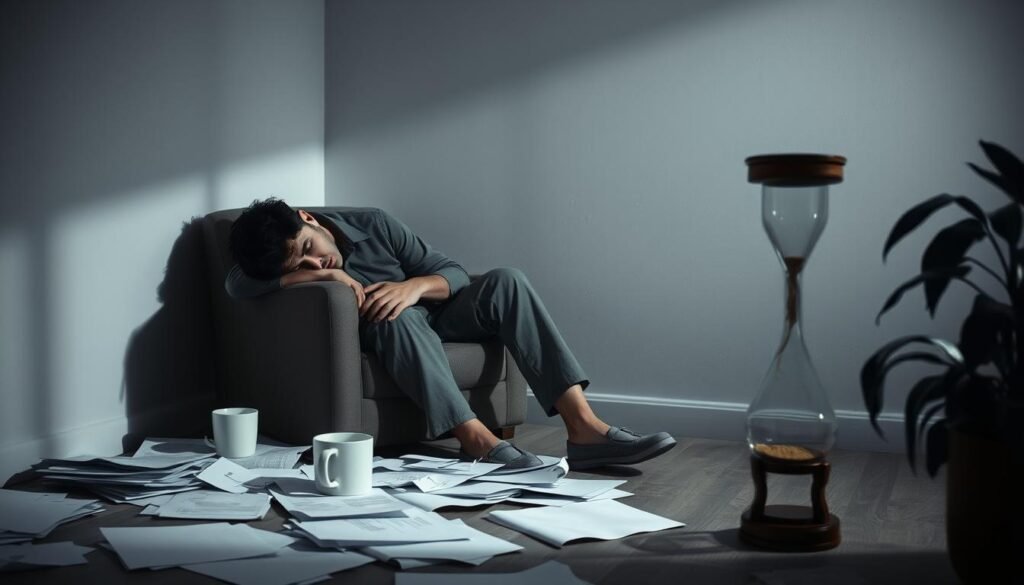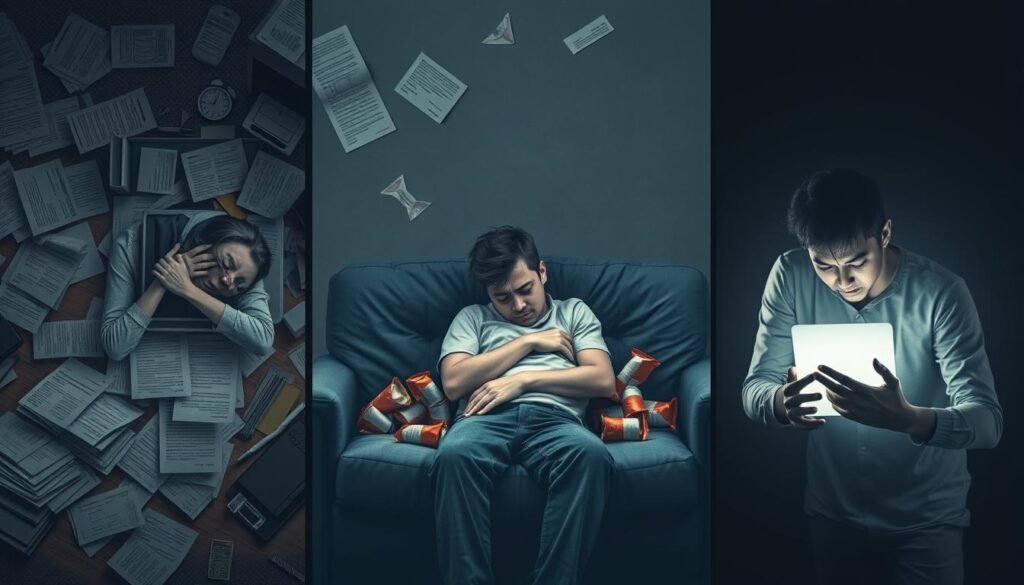About 836,000 to 2.5 million Americans battle with chronic fatigue syndrome (CFS). This condition goes way beyond just feeling tired. It’s a big reason we should understand the different kinds of fatigue. By knowing these – physical, mental, or emotional – people can better describe their feelings. This helps in finding why they feel this way. Knowing what kind of fatigue you have aids in making plans to handle life while staying energized.
We will look into each type of fatigue and how they play a role in our lives. It’s key to tell them apart: physical, mental, and emotional fatigue. This knowledge is the first step towards handling and getting better. To learn more about these types, check out this resource on fatigue types.
Key Takeaways
- Chronic fatigue syndrome affects a significant portion of the American population.
- Understanding the different types of fatigue is crucial for effective management.
- Types of fatigue include physical, mental, and emotional fatigue.
- Identifying symptoms associated with each type can lead to better recovery strategies.
- Fatigue can stem from chronic conditions, nutritional deficiencies, and psychological factors.
Understanding Fatigue
Fatigue is both physically and emotionally draining. It means you feel so tired that daily tasks become hard. Over 90% of people say fatigue stops them from doing everyday things. Knowing about different kinds of fatigue is helpful.
Fatigue has many sources, like life habits, health issues, and mind matters. About 7% of U.S. adults have depression, which often leads to feeling beat. Anemia and chronic obstructive pulmonary disease (COPD) are health issues that make people tired too.
Sleep problems add to fatigue. Nearly 10% of adults have sleep apnea, making them very tired during the day. Insomnia is also a big problem. Not getting enough sleep can even make you think worse.
Lifestyle choices are big in dealing with fatigue. Being inactive can make you feel 50% more tired. Think about your daily habits and their impact on your energy. Understanding and treating fatigue means looking at these personal factors. It helps find the best ways to get better.
What are the 3 types of fatigue?
It’s important to know the different types of fatigue to understand their effects on us. Physical fatigue is very common. It usually happens after hard work, like exercising or even daily chores such as cleaning.
Physical Fatigue Explained
Physical fatigue comes from doing a lot of physical work. It shows up after doing tasks that use a lot of energy, making you feel weaker and less energetic. Illnesses like multiple sclerosis can also cause physical fatigue without much activity. Knowing about this helps people find ways to recover and handle it better.
Characteristics of Physical Fatigue
Physical fatigue has some clear signs, including:
- Muscle weakness, which can make everyday tasks harder.
- Lower stamina, making it tough to keep up with activities for a long time.
- Taking longer to recover after being active.
- It can also occur with other fatigue types, like mental fatigue, reducing energy even more.
Looking into physical fatigue shows its complex nature. It often leads to or adds to other fatigue types, affecting our health and how well we perform.

Mental Fatigue: A Deep Dive
Mental fatigue is one of three key types of tiredness. It comes from long periods of thinking hard and stress. By understanding what causes it, we can boost our productivity and feel better. Looking into why it happens and its signs helps us deal with this common problem.
Causes of Mental Fatigue
Mental fatigue often comes from work stress and not sleeping enough. In our fast-moving world, our brains get really tired when they have to work extra hard. The main reasons include:
- Having to make too many decisions, which leads to poorer choices.
- Too much information, especially from being online a lot, which overwhelms our minds.
- Feeling stressed from personal or work issues.
- Not getting enough sleep makes it hard to control urges and handle emotions, leading to more tiredness.
Symptoms of Mental Fatigue
People with mental fatigue often notice signs that make daily tasks hard. Common symptoms include:
- Brain fog, which makes it tough to focus and think clearly.
- Feeling annoyed and upset easily.
- Putting things off and making snap decisions, which leads to bad choices.
- Feeling physically bad, like having headaches or just not feeling well.
Mental fatigue can make us up to 30% less productive, so it’s important to tackle it. In places where you have to make a lot of decisions, like at work, managing stress and taking care of yourself helps. It shows we all need breaks and should be mindful about our daily choices.
Emotional Fatigue and Its Impact
Emotional fatigue is a big worry, mainly in high-stress spots. It comes from long-lasting emotional stress and conflicts with others. It harms our energy. Knowing about emotional fatigue helps us see how it affects our life and work.
The Link Between Emotions and Energy
Emotions deeply affect our physical and mental energy. Emotional fatigue isn’t just feeling tired. It leads to hopelessness and a lack of desire to do anything. People with tough jobs or constant life stress often feel emotionally drained. Up to 76% of workers face job stress, making emotional tiredness more common.
Prolonged stress can make us 50% less productive. This shows how key emotional health is for good work.
Signs of Emotional Fatigue
It’s key to spot emotional fatigue early. Common signs are:
- Feeling emotionally numb or detached
- Having mood swings or getting easily upset
- Getting headaches or stomach issues
- Having trouble sleeping, like with insomnia
- Being more prone to anxiety and depression
These symptoms link emotional fatigue to overall health. People facing these issues might struggle with daily tasks. About 33% of people dealing with personal or work stress suffer major emotional stress. It’s crucial to address emotional fatigue. This helps create better work conditions and boosts our health.

Comparing the Different Types of Fatigue
It’s important to understand the differences in fatigue types for better management. Each type, physical, mental, and emotional, has unique symptoms. Yet, they deeply influence each other. This part will help us explore how they differ and connect.
How Physical, Mental, and Emotional Fatigue Differ
Physical fatigue comes from doing too much physical work. It makes it hard to keep doing physical tasks. Mental fatigue happens after lots of thinking, leaving you feeling drained. Emotional fatigue is due to stress, making you feel disconnected or too tired to care.
- Physical Fatigue: Linked to physical exertion, leading to exhaustion of muscles.
- Mental Fatigue: Derives from prolonged mental effort, causing cognitive depletion.
- Emotional Fatigue: Stems from emotional stress, resulting in feelings of depletion or disengagement.
Different fatigues bring unique challenges. Physical fatigue might get better with rest. But mental fatigue needs breaks and relaxation to recover.
Interconnectedness of Fatigue Types
The fatigues are interlinked in complex ways. For example, chronic physical fatigue can cause mental and emotional tiredness. This shows their overlap. When you can’t do physical activities, it might stress you out. This can affect your emotions because of the strain of illness or recovery efforts.
| Fatigue Type | Common Causes | Symptoms | Recovery Strategies |
|---|---|---|---|
| Physical Fatigue | Overexertion, lack of sleep | Muscle weakness, lack of energy | Rest, hydration, balanced nutrition |
| Mental Fatigue | Prolonged focus, stress | Cognitive overload, difficulty concentrating | Mental breaks, mindfulness, relaxation techniques |
| Emotional Fatigue | Emotional stress, trauma | Apathy, irritability | Emotional support, therapy, self-care rituals |
Understanding the link between these fatigue types helps in a better recovery. By seeing how they relate, you can address them more fully. This in-depth understanding aids in better daily management.

Understanding Fatigue Types in Daily Life
Fatigue affects people differently. Knowing the types and their examples helps us see their effect on our day. Each kind impacts both personal and work life. Seeing how fatigue shows up helps us spot it in our lives.
Examples of Each Type of Fatigue
Physical fatigue shows when it gets tough to follow an exercise plan. Activities like running or weight lifting feel harder after a long day at work. This makes staying healthy harder, showing how fatigue can affect us.
Mental fatigue often comes up at work. It gets hard to focus or make choices after a busy day. This drops work quality and cuts down on what we get done.
Emotional fatigue hits hard in our relationships. Feeling worn out from non-stop stress or arguments can harm our ties with loved ones. Knowing these examples helps us understand fatigue’s impact better.
Impact on Daily Activities
Chronic fatigue syndrome (CFS) means constant tiredness that doesn’t get better with rest. This makes everyday tasks hard for those with CFS. Up to 80% report tiredness so severe it changes their way of life.
Bad lifestyle choices also lead to more fatigue. About 30% of adults don’t get enough sleep, boosting tiredness. A packed schedule often leads to less sleep, making its impact worse.
Mental health issues can make fatigue worse, leading to more anxiety and depression. Spotting these signs is key. People facing non-stop fatigue should seek help, as the CDC suggests for chronic fatigue syndrome info.
Management and Coping Strategies for Fatigue
Managing fatigue means using self-care techniques to feel better. These strategies can really boost one’s energy and how they function each day.
Self-Care Techniques
There are many ways to fight fatigue. Being active is key, as it fights tiredness. Also, eating well gives you the energy your body needs. And, using mindfulness can help clear your mind.
- Engage in at least 30 minutes of moderate exercise most days of the week.
- Consume a balanced diet rich in fruits, vegetables, lean proteins, and whole grains.
- Practice mindfulness or meditation for 10-15 minutes daily to reduce mental strain.
- Prioritize sleep by aiming for 7 to 10 hours each night for optimal recovery.
- Stay hydrated to maintain overall energy levels throughout the day.
When to Seek Professional Help
Knowing when to get help for chronic fatigue is important. If self-care doesn’t reduce tiredness, seeing a doctor is smart. If you’re tired for six months or more, or it impacts your life, get checked.
Don’t wait to talk to a doctor if you’re always tired or weak. Seeking help is the first step to feeling better. For more info, useful guides are medical recommendations and mental health advice.
Conclusion
Understanding fatigue is key for anyone looking to improve their health and well-being. It’s important to recognize the three kinds of exhaustion—physical, mental, and emotional. Knowing these can help people find the right ways to cope and get help if needed.
Physical fatigue shows up as less strength and stamina. Mental fatigue can make it hard to think clearly. And emotional fatigue might make you feel overwhelmed or disconnected. Each type needs its own way of managing.
Statistics reveal that 5-20% of people often feel tired, with women experiencing it more. Fatigue is a common complaint in doctor’s offices and affects daily life and mental health. Talking about fatigue and its many aspects empowers us to take charge of our health. It also encourages communities to support those struggling.
Learning about the different kinds of exhaustion can lead to better health. As we discover more through research, our ways of dealing with fatigue get stronger. So, staying informed and talking about fatigue, its signs, and how to tackle it is crucial.
Taking control of your health journey can make life richer and more rewarding. It’s vital for patients to keep learning and being part of conversations on this topic.